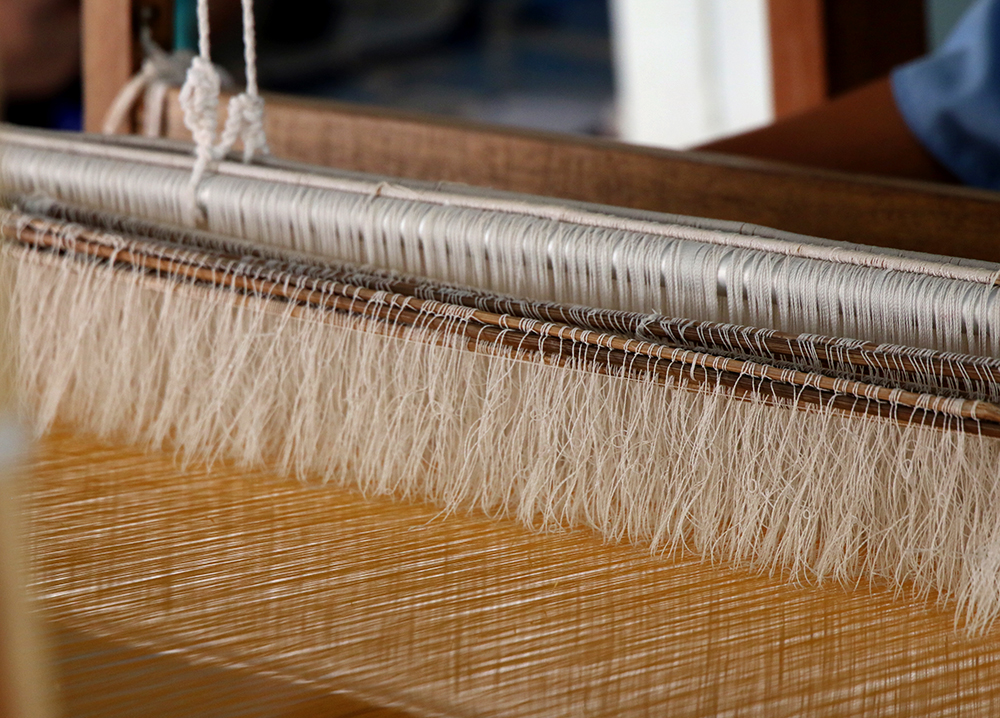Thai Silk Weaving Professional Curriculum: Expansion from Chiang Mai Women Correctional Institution to the Inmates in Lamphun Provincial Prison
Main Article Content
Abstract
Female inmates of the Silk Weaving Vocational Group in Lamphun Provincial Prison encountered the problem of Thai silk weaving that did not meet the Lamphun Yok Dok silk standard. Therefore, the objectives of this research are to apply the results of the silk weaving professional curriculum developed in Chiang Mai Women Correctional Institution into extensive practice by female inmates in Lamphun Provincial Prison; and to study the results of the implementation of the Lamphun Yok Dok Silk Weaving Professional Curriculum in Lamphun Provincial Prison. The participatory action research method was employed; the female inmates of the Silk Weaving Vocational Group in Lamphun Provincial Prison, the professional local weavers with knowledge of silk weaving, scholars, the commander and officers from Lamphun Provincial Prison, and staff of the Queen Sirikit Sericulture Center, Chiang Mai. The following processes were implemented: 1) Improving the Lamphun Yok Dok Silk Weaving Professional Curriculum, 2) Planning the curriculum, 3) Organizing professional training activities, 4) Evaluating the use of the curriculum, and 5) Editing/updating the curriculum. It was found that in the Lamphun Yok Dok Silk Weaving Professional Curriculum, the contents, order of teaching, teaching methods, and group size of learners were appropriate for the development of the Lamphun Yok Dok silk weaving abilities of inmates, and the inmates proposed to improve the curriculum in terms of the duration of learning and teaching and teaching documents. In conclusion, 11 inmates were able to weave the Lamphun Yok Dok silk, 22 silk products were certified as the Royal Peacock Standard, the inmates' ability to teach new inmates the silk weaving procedures which consists of 8 steps and an inmate pursued her career in Yok Dok silk weaving after the release from the Lamphun Provincial Prison.
Article Details

This work is licensed under a Creative Commons Attribution-NonCommercial-NoDerivatives 4.0 International License.
Area Based Development Research Journal values copyright protection and licensing to safeguard author rights and facilitate the appropriate dissemination of research. Our policies ensure openness, accessibility, and attribution. Authors retain copyright ownership, and articles are published under a Creative Commons Attribution License (CC BY), allowing sharing, adaptation, and proper attribution. Authors have the freedom to publish under the CC BY license, granting broad reuse and distribution permissions. The journal supports posting articles on third-party repositories, adhering to institutional and funding restrictions. Author guidelines detail copyright and licensing requirements, empowering authors with knowledge about their rights and responsibilities. These policies cultivate an environment of collaboration, openness, and responsible sharing, benefiting authors and the research community while honoring intellectual property rights.
References
Chukampaeng, C. (2016). Curriculum research and development: Concepts and processes. Bangkok: Chulalongkorn University. (in Thai).
Department of Corrections. (n.d.). Missions and duties of the Department of Corrections. Retrieved June 27, 2022, from: http://www.correct.go.th. (in Thai).
Department of Intellectual Property. (2020). Registration of Thai Geographical Indications. Retrieved June 27, 2022, from: https://www.ipthailand.go.th. (in Thai).
Lamphun Provincial Prison. (2020). Inmates statistics report for the day. Lamphun Provincial Prison. (in Thai).
Nguesupa, A., Karoonlanchakorn, S., & Mankoksoong, P. (2017). Guidelines of transferring local wisdom of The Silk Weaving Group in Nong Khae Village, Tongkhob sub-district, Khoksisuphan district, Sakon Nakhon province to the new generation. Graduate Studies Journal, 14(64), 95-102. (in Thai).
Phupan, S. (2003). Fundamental concepts of curriculum creation and development. Chiang Mai: The Knowledge Center. (in Thai).
Prajonsant, S. (2020). The learning process of hand-woven silk design and product for Silk Tourist Village, Buriram province. Area Based Development Research Journal, 12(2), 132-143. (in Thai).
Thiensiri, J., & Potipruek, N. (2021). Lessons learned from the guidelines for the establishment of Thai silk weaving training group in the Chiang Mai Women Correctional Institution. Graduate School Journal Chiang Rai Rajabhat University, 14(2), 1-15. (in Thai).
Thiensiri, J., Kaweera, S., & Potipruek, N. (2017). Thai silk weaving vocational curriculum development for Chiang Mai Women Correctional Institution. FEU Academic Review Journal, 11(3), 211-225. (in Thai).
Tumtong, B. (2011). Curriculum development. Bangkok: Active Print. (in Thai).


